- Skip to primary navigation
- Skip to main content
- Skip to primary sidebar

- FREE Experiments
- Kitchen Science
- Climate Change
- Egg Experiments
- Fairy Tale Science
- Edible Science
- Human Health
- Inspirational Women
- Forces and Motion
- Science Fair Projects
- STEM Challenges
- Science Sparks Books
- Contact Science Sparks
- Science Resources for Home and School

How to Make a Naked Egg
May 20, 2015 By Emma Vanstone 1 Comment
Do you know how make a naked egg ? It’s super simple and a great fun science experiment for kids of all ages. A naked egg is an egg with no shell. Can you imagine such a thing? The shell dissolves in vinegar, but the membrane stays intact.
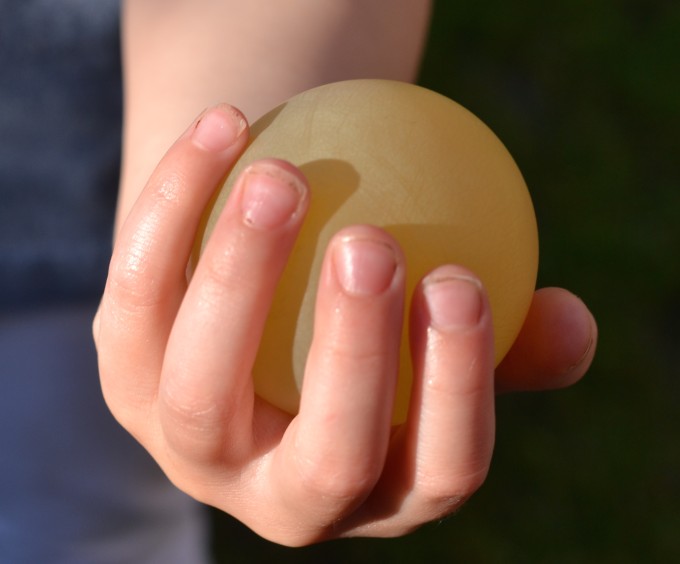
What you need to make a naked egg
How to remove the shell from an egg.
Place a raw egg in a jar and completely cover with vinegar.
Leave for 24 hours and rinse gently under cold water, carefully rubbing away the shell. If there’s still some shell left, put the egg back in the vinegar and check again after a few hours.
The shell should rub off as a white powdery substance. Once you’ve removed the shell you’ll find the egg feels rubbery and is a bit bigger than when it had the shell. This is because some of the vinegar has moved into the egg through the membrane by a process called osmosis .
You can speed the process up by rinsing and changing the vinegar every 3 hours.
Why does the egg shell dissolve in vinegar
The acid ( acetic acid in the vinegar ) reacts with calcium carbonate in the egg shell. This dissolves the eggshell leaving just the membrane behind.
You should see bubbles appear when the egg in in the vinegar, this is carbon dioxide being released as part of the reaction.
Fun things to do with naked eggs
Bounce them! Try dropping your naked egg from different heights, starting low and then moving higher until the egg breaks.
Use your egg with no shell to learn about osmosis . The egg membrane is semi permeable which allows water to pass through it. If you put place the egg in coloured water you’ll find the egg turns the colour of the water!
More Egg Experiments
Try one of these fun Eggy experiments .
Use eggs to learn how to keep teeth healthy . The composition of egg shell is similar to teeth so makes a great substitute as you obviously can’t experiment on your own teeth!
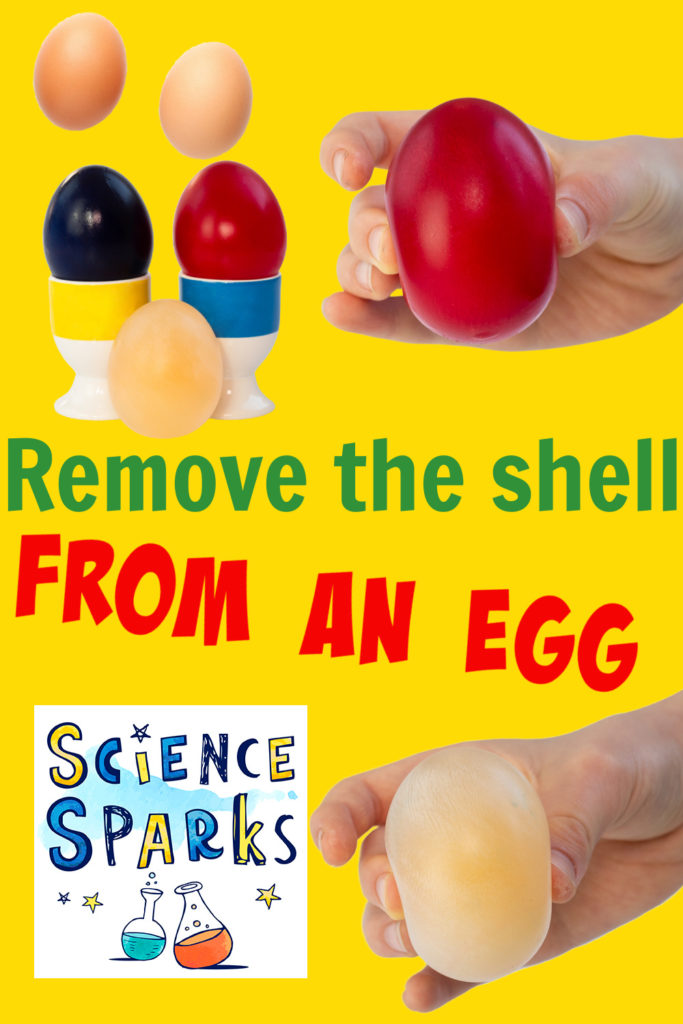
Last Updated on March 3, 2021 by Emma Vanstone
Safety Notice
Science Sparks ( Wild Sparks Enterprises Ltd ) are not liable for the actions of activity of any person who uses the information in this resource or in any of the suggested further resources. Science Sparks assume no liability with regard to injuries or damage to property that may occur as a result of using the information and carrying out the practical activities contained in this resource or in any of the suggested further resources.
These activities are designed to be carried out by children working with a parent, guardian or other appropriate adult. The adult involved is fully responsible for ensuring that the activities are carried out safely.
Reader Interactions
March 30, 2021 at 8:23 am
is the egg edible after the vinegar has removed the shell?
Leave a Reply Cancel reply
Your email address will not be published. Required fields are marked *
.png)
The Naked Egg Experiment

Spring time brings sweet smelling flowers, buzzing insects and of course, egg hunts! In recognition of all things spring, this Science Experiment examines chemical reactions using an egg. Follow the simple steps below to completely remove the shell from an egg, without breaking anything. All it takes is some patience and science!
Items Needed:
- Large glass or non-metallic container
- Start by submerging one raw egg in a container full of vinegar. You should see mini bubbles forming around the shell. This is a chemical reaction taking place. Take pictures to see compare how the egg changes.
- Leave the egg in the container of vinegar for 24 hours. You might notice a white film on the top of the vinegar as the shell breaks down. This is normal.
- On the second day, throw away the vinegar in the cup and replace with fresh vinegar. We’d recommend using your hand or a strainer to “catch” the egg, and not a spoon. Spoons can break the egg. Put the cup and egg aside for another full day and don’t disturb the egg. Take another picture to compare at the end.
- On the third day, pour off the vinegar and carefully rinse the egg under water. Be gentle with the egg. The shell should be completely gone and you should see the membrane that surrounds the white and yolk.
- Examine the way it moves. Shine a flashlight through the egg and see what happens. What size is the egg now? How does it look different from the beginning?
What Happened?
Eggshells are made of calcium carbonate and vinegar contains acetic acid. The acid reacts with the calcium carbonate and makes calcium acetate plus water and carbon dioxide. This is what all those wee bubbles are. This reaction eats through the shell leaving behind a “naked” egg.
Safety Note
Remember to wash your hands after handling the naked egg at any point in this experiment. Eggs can contain salmonella, so scrub away.
Do not eat this egg. This is not a safe way to prepare an egg for consumption.
More Experiments

Northern Virginia Science Center Foundation is a 501(c)(3) non-profit organization that operates the Children's Science Center Lab at Fair Oaks Mall and STEM programs traveling to schools and other community venues across the region. The Foundation is also developing the Northern Virginia Science Center in Dulles, VA, a world-class, interactive regional science center for families, students and learners of all ages made possible through a pivotal public-private partnership. Learn more about our mission today at childsci.org and our vision for the future at novasci.org.
Plan Your Experience
Events & programs, get involved.

- 1 drinking glass
- Plastic wrap (or something else to cover the glass with)
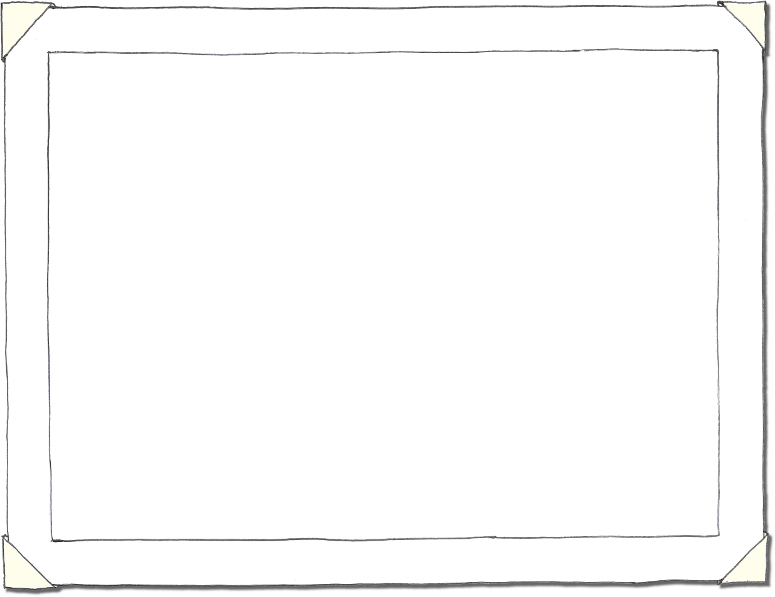
Short explanation
Long explanation.
- What does the egg look like after 1 hour, 2 hours, 6 hours, 12 hours, 1 day, 2 days and so on?
- What happens if you place the naked egg in pure water, salt water, syrup etc.?
- How is the egg yolk affected compared to the egg white?

Rubber chicken bone

Gummy bear osmosis

Plastic bag and pencils

Screaming dry ice

Dry ice in a balloon

Special: Dry ice color change
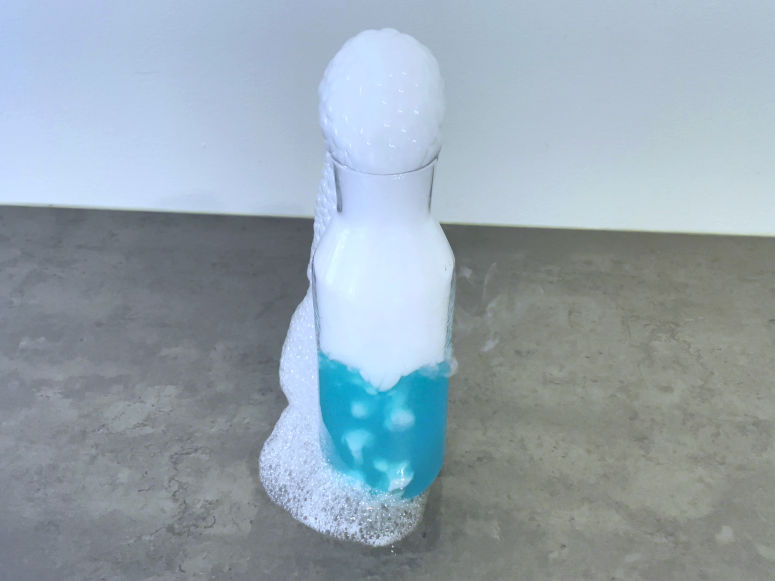
Dry ice smoking soap bubble snake

Dry ice giant crystal ball bubble

Dry ice in water

Rainbow milk

Floating ping pong ball

Rotating Earth

Special: Colored fire

Special: Fire bubbles

Water cycle in a jar

Egg drop challenge

Taking the pulse

Orange candle

Glass bottle xylophone

Warped spacetime

Homemade rainbow

Water implosion

Warm and cold plates

Plastic bag kite

Tamed lightning

Yeast and a balloon

Forever boiling bottle

Moon on a pen

Moon in a box

Inexhaustible bottle

Crystal egg geode

Magic ice cut

Leaf pigments chromatography

Heavy smoke

Popsicle stick bridge

Micrometeorites

Special: Fire tornado

Special: Whoosh bottle

Dancing water marbles

Brownian motion

Flying static ring

Water thermometer

String telephone

Special: Dust explosion

Disappearing styrofoam

Special: Burning money

Special: Burning towel

Salt water purifier

Fish dissection

Hovering soap bubble

Homemade sailboat

Water mass meeting


Water sucking bottle

Water sucking glass

Mentos and coke

Aristotle's illusion

Spinning spiral snake

Imploding soda can

Carbon dioxide extuingisher

Plastic bag parachute

Dental impression

Impact craters

Rolling static soda can

Static paper ghost

Color changing flower

Upside down glass

Shrinking chip bag

Solar system model

Strawberry DNA

Electric motor

Flashy electric motor

Bouncing soap bubbles

Toilet paper roll maraca

Cloud in a bottle 1

Cloud in a bottle 2

Balloon rocket

Water whistle

Homemade yogurt

Special: Screaming gummy bear

Homemade compass

Trash airplane

Wind-up spinner toy

Tea bag rocket

Balancing soda can

Lung volume test

Fireproof balloon

Baking powder popper

Expanding space

Straw propeller

Wooden cutlery

Levitating match

Human reflexes

Electromagnet

Soil layers

Straw potato

Straw rocket launcher

Traveling flame

Water bowls

Straw duck call

Solar eclipse

Silo of salt

Balloon skewer

Newspaper tower

Microwave light bulb

Heavy paper

Homemade marble run

Drops on a coin

Cartesian diver
Content of website.

© Exploratorium - Use Policy - Privacy Policy

Naked Egg (Dissolving Egg Shell) Experiment
- April 30, 2019
- 3-4 Year Olds , 5-6 Year Olds , Chemistry , Household Items , Popular
Simple science experiments for kids: Do you want show naked egg to your kids? Try this fun project by dissolving an eggshell into a glass of vinegar solution.

Try this simple activity which involves absolutely no complication but only fun. And you know what? There is no need to run around to shop for materials because you can find everything from your household items . Trust me, we tried this experiment couple of time in the last 15 days as kids kept on insisting to watch the reactions. Also, my little princess Tisha did not allow the result show and interrupted every time out of curiosity.
Dissolving the Eggshell from an Egg & Making Transparent Egg
What is required?
- Vinegar (White )

- Place the egg in the glass jar
Make sure your jar is not heavy and let kids handle them easily. Ask them to place the egg into the glass jar. Ensure it does not break and provide help to kids. Preferably use a wide-mouthed glass so that easily hands can go inside. Also, there will be rooms for the egg to swell.
- Mix Vinegar Solution Now, take vinegar and transfer that to the jar until it covers the entire egg. Finally, add few more drops to make sure that eggs are floating. Initially, the egg will float when it is fresh and then sink.

The fun begins quickly after adding the vinegar to the jar and you can witness minute bubble formation on outer layer of the egg. This is due to the release of CO 2 (carbon dioxide). Imagine the fizzy sound when opening any aerated juice. This is similar to that chemical reaction which happens n the jar.

- Close the jar and keep it aside for a maximum of 7 days
Osmosis takes places making the egg to swell and also the color of the eggshell fades from brown. A scummy layer is formed on the surface and it is good to change the Vinegar solution when you witness this layer formation. However, it is optional and does not bother if you forgot to do it or just don’t have time.
- It’s time to empty the vinegar from the jar and take the egg outside. Wash off the residual eggshell.
Wow! You can see the naked egg without eggshell. It is now soft like a sponge and light in weight. In case, the eggshells are hard to remove, then don’t panic it needs more days and some more vinegar. So wait with patience to enjoy watching and touching the naked egg soft as a sponge. 🙂
These are cool to look at and also you can find the intact membrane inside. It feels rubbery to touch and squeezing them gently adds fun. It is now possible to see through the lucid egg which contains the yolk. Also, they are seen floating on the top.

The reaction between an acid solution and a base can be demonstrated using this activity. The acetic acid present in vinegar reacts with the shell which is nothing but calcium carbonate. Therefore vinegar is acidic and eggshell is the base.
The reaction between acetic acid + calcium carbonate forms a compound that is soluble in water and named as calcium acetate. Along with this CO 2 is released. Thus the eggshell gets dissolved and the inner membrane remains unaltered giving an appearance of an exposed egg.
Tisha could not understand the science but activity took part in the experiment. She is too small for the explanation part. She expressed interest to carefully take an egg from the refrigerator and drop in the glass jar. Then she added vinegar to the egg in the jar and closed the jar with the lid. She enjoyed watching the bubbles. She counted days and waited to take the egg out of the jar and wash to remove the residual shells. She was amazed at the texture of the egg and ready for a camera shoot. I am glad she is so involved but at the cost of breaking some eggs. Still, she enjoyed.
Therefore, we discussed the texture of the egg from the beginning of the experiment (hard) until the end (spongy). All the time during the discussion Tisha was busy meddling with the egg squeezing softly and bouncing on the floor.
However, Pritika being elder started asking questions of how and that led to learning a bit of chemistry and chemical reactions. Though she is not old enough to understand reactions but certainly gained knowledge about the science involved in this experiment. She got an idea about elements, molecule, etc. She now knows that elements make up the molecules and the entire world has elements in it.
We then discussed molecules, acids, base, and reactions. Also, she understood that lemon contains citric acid. Out stomach has some acids to digest food etc. Also, she understood that acid reacting with the base like baking soda will make a fizzy sound. She knows the uses of baking soda because of our “making of Anzac Biscuits ” experiment. We also did the erupting volcano experiment a month ago which helped her to understand this one easier.
But today she saw vinegar reacting with a base other than baking soda and understood the chemical reaction. During the entire process, I explained to her about vinegar, its properties, and eggshell properties, etc. Also, told her how CO 2 bubbles escaped, etc. This is my small initiative to expand her knowledge with practical experiments.

Do not view the activity as edible. As we have used vinegar to dissolve eggshell formation bacteria will not be a cause for concern. Egg absorbs the vinegar and this process is osmosis. However, we advise you to not use this egg in cooking.
We have extended this experiment to make colorful Rainbow Rubber Eggs

If you are interested in more dissolving egg experiments, refer to the below links:
- Making Naked Eggs | Explanatorium
- Bouncy Eggs | Childhood101
- How to Make a Naked Egg (video) | Imagination Station Toledo
- 20+ Science Experiments with Eggs
Or if you are just looking for a science project for upcoming easter, here are some:
Create your own Easter Egg shaped bubble wands (identify what shape bubbles will come out )
Do follow our Go Science Girls board on pinterest to know upcoming science experiments.
Subscribe to our newsletter , we will send you our latest experiments right to your inbox. We would love to have you on board with us!

How to make a Naked Egg
A “naked egg” is an egg that has no shell. Let me say that again, an egg with no shell. This is not something you normally run across and even when I show a naked egg to someone they often just don’t get the idea that the shell is gone – yet the egg stays intact. You might want to check out the anatomy of an egg to get an idea what we are dealing with.
The shell of an egg (typically a chicken egg) is made up of primarily calcium carbonate. If you soak this egg shell in vinegar (which is about 4% acetic acid), you start a chemical reaction that dissolves the calcium carbonate shell. The acetic acid reacts with the calcium carbonate in the egg shell and releases carbon dioxide gas that you see as bubbles on the shell.
CaCO 3 ( s ) + 2 HC 2 H 3 O 2 ( aq ) → Ca(C 2 H 3 O 2 ) 2 ( aq ) + H 2 O ( l ) + CO 2 ( g )
The egg insides remain intact and are held together by the two fragile membranes just inside the shell.
Here’s what you need
Let’s get to the fun stuff. In order to make a Naked Egg you will need the following items:
Vinegar (at least 16 ounces)
A couple of glasses or cups
The process is really very simple. Carefully place the egg in a cup and fill the cup with vinegar so that the egg is completely covered. Don’t worry if the egg floats a bit. Just get enough vinegar in the cup to mostly cover the egg.
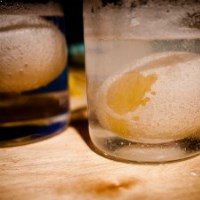
Now the hard part – you will have to wait as the acetic acid in the vinegar begins to react with the calcium in the egg shell. In just a short while, you should see some bubbles appearing on the outside of the egg. These are bubbles of carbon dioxide gas from the reaction. It can take 12-24 hours before a good portion of the shell is removed. A good sign of progress is a white frothy scummy layer on the top of the surface of the vinegar.
After a day of soaking you can carefully remove the egg from the vinegar. I would suggest pouring the liquid into another cup and catching the egg in your hand. Using a spoon to fish the egg out might seem like a good idea, but I’ve seen a few eggs break or get damaged when using a spoon to remove them.
At this point you may be able to literally rub the shell off the egg with your fingers. It will rub off as a white powdery substance. Give it try, just be very careful, you don’t want to break the egg, it’s getting more fragile as the shell is slowly dissolved. Depending on your particular egg, you may already have a naked egg. However, I would suggest you fill a cup with fresh vinegar and soak the egg for at least one more day.
After two days of soaking you should have a pretty cool Naked Egg. Notice that the egg is a bit bigger than when you first started. This is because some of the vinegar (and some of the water in the vinegar) has moved through the membranes to the inside of the egg. The membranes are semi-permeable and allow water to move through them. This is called osmosis.
Fun things to do with your naked eggs
Naked eggs are cool, but experimenting with them is even cooler. You have probably already noticed that your naked egg is kind of rubbery. How far above the table can you drop your egg and have it survive by bouncing? I would suggest you start at one inch, then try two inches, and so on. Keep in mind that eventually this is going to get messy when it the membrane breaks. You might want to do this experiment outside.
If you want to see your egg get really big, simply put it in a cup filled with water. The makeup of the inside of the egg is around 90% water. If you put the egg in a cup of (100%) water, the water will begin to move inside the egg through the membrane to equalize the amount of water inside and outside of the egg membrane. This process of water moving through a membrane is called osmosis. Osmosis equalizes – or makes the concentration of water on both sides of the egg membrane the same. This means the egg will swell as the water moves inside and get larger.
You can even color the inside of your egg if you soak it in some water with food coloring. This is a nice way to verify that the water in the cup is really moving through the egg membrane and not just coloring the outside.
Shrink your Egg
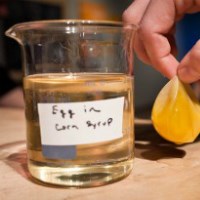
Now that you know about osmosis, you might ask “can I make my egg shrink” or shrivel up? Of course, you just need a liquid that has only a little bit of water. A common substance you may have at home that fits this requirement is corn syrup.
Slip your Naked Egg into a cup filled with corn syrup and let it sit for a day, or two, or more and you will begin to see your egg begin to shrink and look sort of baggy. Corn syrup has very little water content. Once inside the syrup, the water inside the egg begins to move across the semi-permeable egg membrane to equalize the water concentration. Again, that’s osmosis at work. If you leave your egg in the syrup long enough it will begin to look something like a huge raisin – with of course a yoke inside.
If you get tired of the shriveled egg look, you can reverse the process by just dunking the egg back in a cup of water. The water will once again move across the membrane and fill the egg with water again.
A big thank you to one of our visitors who grabbed a great photo of what happens when you soak a naked egg in corn syrup for a few days. I might call it a “dehydrated naked egg.” And side-by-side is a brilliant red naked egg soaked in red food coloring. Thank you Evers Ding for permission to use your photo and check out the rest of Evers egg photos on his blog .
Can I eat the Naked Egg?
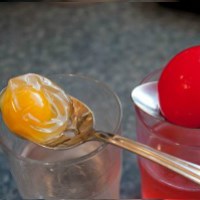
Several visitors have posed the question, “Can I eat my naked egg?” I would N OT recommend eating a naked egg prepared this way. Keep in mind you created your egg by soaking a raw egg in vinegar sitting at room temperature for a few days. That is not how to treat eggs you are going to eat! Even if you stored the egg in the refrigerator, I still would not recommend eating the raw egg. Some have asked if you could store the egg in the fridge, then cook it and eat it. Well, I suppose you could, but given the amount of vinegar that probably moved past the membrane into the egg, it’s most likely not going to taste all that great. Instead of eating your naked egg, just experiment with it.
Look, if you are really interested in creating a Pickled Egg that you can eat , check out some of the recipes from the National Center for Home Food Preservation and for more information about safe egg handling practices check out the Egg Safety Center .
Does it Smell?
A few of you asked if the eggs will start to have that rotten egg odor after a while. Well, I think it depends on how you store the egg. That rotten egg odor comes from hydrogen sulfide. Eggs contains sulfur because it is needed for the production of feathers in the chicken.
I have not noticed any bad odors with my naked eggs. After dissolving the shell in the vinegar, I keep the egg in a glass of water for up to a week and have not noticed any odor when the egg does accidentally break. It would be an interesting (and probably stinky) experiment to leave an egg out for a week or two in order to give it a chance to start to decompose. I would suspect that as the contents start to decompose, sulfide compounds will begin to form and it will start to smell really bad.
Science Fair Project Ideas
In terms of doing a science fair project here are a couple variables you might want to explore in more detail. Just a list of ideas to get you thinking. If you come up with other ideas let me know!
- Change in the weight of the egg .The egg will swell as water is passes through the membrane after the shell is removed. If you have a scale that measures to something like a tenth or hundredth of a gram, you may be able to measure the weight of the egg from start to finish and estimate how much water is absorbed. Perhaps your school has a scale that could be used for this? You could also soak the egg in corn syrup and chart the loss of water as it moves out of the egg. Could be messy as you would want to carefully wash off the syrup to make your weight measurements.
- Does temperature make a difference in how long it takes to remove all the shell? Eggs in vinegar in the fridge versus at room temperature vs simmering an egg in warm vinegar on the stove. Could be smelly.
- Strength of the egg membrane . First make a dozen naked eggs so you can do multiple trials. Then test how much weight it will take to burst the membrane. This could be done by pressing ever increasing weight on the egg, or by dropping the eggs from successively higher heights until the membrane fails. This will probably be messy!
I’ve received many requests from students doing science fair projects related to the Naked Egg looking for further or deeper references. I have included some print references below. You can use the World Library Catalog to locate one of these items in a library near you!
B. Z. Shakhashiri, Chemical Demonstrations: A Handbook for Teachers of Chemistry , Vol 3, p. 283-285, Wisconsin (1989).
B. Cocanour and A. S. Bruce, J. College Sci. Teach . 15:127 (1985)
V. L. Mullin, Chemistry Experiments for Children , Sterling Publishers: New York (1961).
L. A. Ford, Chemical Magic , T. S. Denison and Co.: Minneapolis, Minnesota (1959).

IMAGES
COMMENTS
De-shell the eggs by placing them in a large container so that they touch as little as possible. Add vinegar to cover the eggs (see photo below), and cover the container. Allow the eggs to sit for 24 to 48 hours at room temperature. Note: Changing out the vinegar halfway through and replacing it with fresh vinegar will speed up the process.
Jun 27, 2022 · The egg in vinegar experiment, also known as a “naked egg” or “bouncy egg”, is the perfect simple STEM activity. Kids and adults alike will enjoy squeezing and bouncing the naked egg. It’s so cool to see an egg staying together without its shell!
May 20, 2015 · What you need to make a naked egg. Raw eggs. Jar. Vinegar. How to remove the shell from an egg. Place a raw egg in a jar and completely cover with vinegar. Leave for 24 hours and rinse gently under cold water, carefully rubbing away the shell. If there’s still some shell left, put the egg back in the vinegar and check again after a few hours.
Spring time brings sweet smelling flowers, buzzing insects and of course, egg hunts! In recognition of all things spring, this Science Experiment examines chemical reactions using an egg. Follow the simple steps below to completely remove the shell from an egg, without breaking anything. All it takes is some patience and science! Items Needed ...
The egg looks translucent because the shell is gone! The only thing that remains is a delicate membrane of the egg surrounding the white and the yolk. You’ve successfully made an egg without a shell. Okay, you didn’t really make the egg (the chicken made the egg), you just stripped away the chemical that gives the shell its strength.
The naked egg experiment is the perfect eggsperiment for a science fair project! Make several naked eggs to perform a science experiment with eggs in different liquids and learn about osmosis. With one egg in corn syrup and other eggs in salt water or seltzer water, kids may be surprised how the naked eggs change!
An eggshell consists of hard calcium carbonate. But the vinegar causes the eggshell to dissolve. What remains is a "naked egg" - an egg without a shell! However, it is still held together by two thin membranes and therefore feels like a rubber egg. Long explanation The shell of an egg consists almost entirely of calcium carbonate (CaCO 3 ).
Put one of your shell-less eggs into a small container and add enough corn syrup to cover the egg. Put another egg in a small container and add enough water to cover the egg. Put both eggs in your refrigerator for 24 hours. 2. After 24 hours, take a look at your eggs. What’s happened?
Apr 30, 2019 · Then she added vinegar to the egg in the jar and closed the jar with the lid. She enjoyed watching the bubbles. She counted days and waited to take the egg out of the jar and wash to remove the residual shells. She was amazed at the texture of the egg and ready for a camera shoot. I am glad she is so involved but at the cost of breaking some eggs.
After dissolving the shell in the vinegar, I keep the egg in a glass of water for up to a week and have not noticed any odor when the egg does accidentally break. It would be an interesting (and probably stinky) experiment to leave an egg out for a week or two in order to give it a chance to start to decompose.